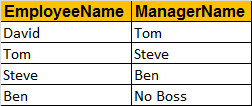We will be using Employees table to understand how a recursive CTE works.

Here is the recursive CTE that gets the organization hierarchy based on an EmployeeId. Notice that the recursive CTE has got 2 parts (Anchor & Recursive Member)
Declare @ID int;
Set @ID = 7;
WITH EmployeeCTE AS
(
-- Anchor
Select EmployeeId, EmployeeName, ManagerID
From Employees
Where EmployeeId = @ID
UNION ALL
-- Recursive Member
Select Employees.EmployeeId , Employees.EmployeeName, Employees.ManagerID
From Employees
JOIN EmployeeCTE
ON Employees.EmployeeId = EmployeeCTE.ManagerID
)
Select E1.EmployeeName, ISNULL(E2.EmployeeName, 'No Boss') as ManagerName
From EmployeeCTE E1
LEFT Join EmployeeCTE E2
ON E1.ManagerID = E2.EmployeeId
When David's EmployeeId is passed the query produces the following output

Let's now discuss how the CTE executes line by line.
Step 1: Execute the anchor part and get result R0
Step 2: Execute the recursive member using R0 as input and generate result R1
Step 3: Execute the recursive member using R1 as input and generate result R2
Step 4: Recursion goes on until the recursive member output becomes NULL
Step 5: Finally apply UNION ALL on all the results to produce the final output





.png)
0 comments:
Post a Comment
Note: only a member of this blog may post a comment.